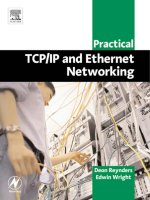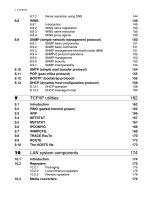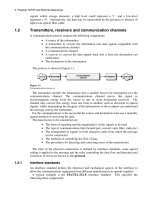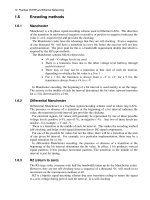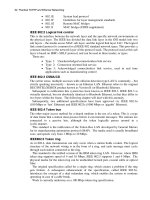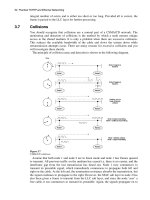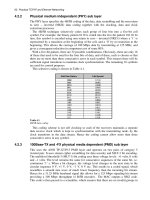Practical TCP/IP and Ethernet Networking- P5 pps
Bạn đang xem bản rút gọn của tài liệu. Xem và tải ngay bản đầy đủ của tài liệu tại đây (306 KB, 10 trang )
6XGIZOIGR:)6/6GTJ+ZNKXTKZ4KZ]UXQOTM
through the common upper and lower boundaries by passing physical information
through service access points (SAPs). A SAP could be compared to a predefined
‘postbox’ where one layer would collect data from the previous layer. The relationship
between layers, entities, functions and SAPs is shown in Figure 2.6.
Figure 2.6
Relationship between layers, entities, functions and SAPs
In the OSI model, the entity in the next higher layer is referred to as the N+1 entity and
the entity in the next lower layer as N–1. The services available to the higher layers are
the result of the services provided by all the lower layers.
The functions and capabilities expected at each layer are specified in the model.
However, the model does not prescribe how this functionality should be implemented.
The focus in the model is on the ‘interconnection’ and on the information that can be
passed over this connection. The OSI model does not concern itself with the internal
operations of the systems involved.
When the OSI model was being developed, a number of principles were used to
determine exactly how many layers this communication model should encompass. These
principles are:
• A layer should be created where a different level of abstraction is required
• Each layer should perform a well-defined function
• The function of each layer should be chosen with thought given to defining
internationally standardized protocols
• The layer boundaries should be chosen to minimize the information flow
across the boundaries
• The number of layers should be large enough that distinct functions need not
be thrown together in the same layer out of necessity and small enough that
the architecture does not become unwieldy
The use of these principles led to seven layers being defined, each of which has been
given a name in accordance with its process purpose. The diagram below shows the seven
layers of the OSI model.
4KZ]UXQOTML[TJGSKTZGRY
Figure 2.7
The OSI reference model
The service provided by any layer is expressed in the form of a service primitive with
the data to be transferred as a parameter. (A service primitive is a fundamental service
request made between protocols. For example, layer W may sit on top of layer X. If W
wishes to invoke a service from X, it may issue a service primitive in the form of
X.Connect.request to X. An example of a service primitive is shown in Figure 2.8.
Service primitives are normally used to transfer data between processes within a node.
Figure 2.8
Service primitive
Typically, each layer in the transmitting site, with the exception of the lowest, adds
header information, or protocol control information (PCI), to the data before passing it
through the interface between adjacent layers. This interface defines which primitive
operations and services the lower layer offers to the upper one. The headers are used to
establish the peer-to-peer sessions across the sites and some layer implementations use
the headers to invoke functions and services at the N+1 or N–1 adjacent layers.
At the transmitter, the user invokes the system by passing data, primitive names and
control information physically to the highest layer of the protocol stack. The system then
passes the data physically down through the seven layers, adding headers (and possibly
trailers), and invoking functions in accordance with the rules of the protocol. At each
level, this combined data and header ‘packet’ is termed a protocol data unit or PDU. At
the receiving site, the opposite occurs with the headers being stripped from the data as it
is passed up through the layers. These header and control messages invoke services and a
peer-to-peer logical interaction of entities across the sites. Generally, layers in the same
6XGIZOIGR:)6/6GTJ+ZNKXTKZ4KZ]UXQOTM
site communicate with parameters passed through primitives, and peer layers across sites
communicate with the use of the protocol control information, or header.
At this stage, it should be quite clear that there is NO connection or direct
communication between the peer layers of the network. Rather, all physical
communication is across the physical layer, or the lowest layer of the stack.
Communication is down through the protocol stack on the transmitting stack and up
through the stack on the receiving stack. Figure 2.9 shows the full architecture of the OSI
model, whilst Figure 2.10 shows the effects of the addition of PCI to the respective PDUs
at each layer. As will be realized, the net effect of this extra information is to reduce the
overall bandwidth of the communications channel, since some of the available bandwidth
is used to pass control information.
Figure 2.9
Full architecture of OSI model
Figure 2.10
OSI message passing
4KZ]UXQOTML[TJGSKTZGRY
59/RG_KXYKX\OIKY
Briefly, the services provided at each layer of the stack are:
• Application
Provision of network services TO the user’s application programs
Note: the user’s actual application programs do NOT reside here
• Presentation
Maps the data representations into an external data format that will enable
correct interpretation of the information on receipt. The mapping can also
possibly include encryption and/or compression of data
• Session
Control of the communications between the users. This includes the
grouping together of messages and the coordination of data transfer between
grouped layers. It also affects checkpoints for (transparent) recovery of
aborted sessions
• Transport
The management of the communications between the two end systems
• Network
Responsible for the control of the communications network. Functions
include routing of data, network addressing, fragmentation of large packets,
congestion and flow control.
• Data link
Responsible for sending a frame of data from one system to another.
Attempts to ensure that errors in the received bit stream are not passed up
into the rest of the protocol stack. Error correction and detection techniques
are used here
• Physical
Defines the electrical and mechanical connections at the physical level, or
the communication channel itself. Functional responsibilities include
modulation, multiplexing and signal generation.
A more specific discussion of each layer is now presented.
'VVROIGZOUTRG_KX
The application layer is the topmost layer in the OSI reference model. This layer is
responsible for giving applications access to the network. Examples of application-layer
tasks include file transfer, electronic mail (e-mail) services, and network management.
Application-layer services are much more varied than the services in lower layers,
because the entire range of application and task possibilities is available here. The
specific details depend on the framework or model being used. For example, there are
several network management applications. Each of these provides services and functions
specified in a different framework for network management. Programs can get access to
the application-layer services through application service elements (ASEs). There are a
variety of such application service elements; each designed for a class of tasks. To
accomplish its tasks, the application layer passes program requests and data to the
presentation layer, which is responsible for encoding the application layer’s data in the
appropriate form.
6XGIZOIGR:)6/6GTJ+ZNKXTKZ4KZ]UXQOTM
6XKYKTZGZOUTRG_KX
The presentation layer is responsible for presenting information in a manner suitable for
the applications or users dealing with the information. Functions such as data conversion
from EBCDIC to ASCII (or vice versa), use of special graphics or character sets, data
compression or expansion, and data encryption or decryption are carried out at this layer.
The presentation layer provides services for the application layer above it, and uses the
session layer below it. In practice, the presentation layer rarely appears in pure form, and
it is the least well defined of the OSI layers. Application- or session-layer programs will
often encompass some or all of the presentation layer functions.
9KYYOUTRG_KX
The session layer is responsible for synchronizing and sequencing the dialog and packets
in a network connection. This layer is also responsible for making sure that the
connection is maintained until the transmission is complete, and ensuring that appropriate
security measures are taken during a ‘session’ (that is, a connection). The session layer
is used by the presentation layer above it, and uses the transport layer below it.
:XGTYVUXZRG_KX
In the OSI reference model, the transport layer is responsible for providing data transfer
at an agreed-upon level of quality, such as at specified transmission speeds and error
rates. To ensure delivery, outgoing packets are assigned numbers in sequence. The
numbers are included in the packets that are transmitted by lower layers. The transport
layer at the receiving end checks the packet numbers to make sure all have been delivered
and to put the packet contents into the proper sequence for the recipient. The transport
layer provides services for the session layer above it, and uses the network layer below it
to find a route between source and destination. The transport layer is crucial in many
ways, because it sits between the upper layers (which are strongly application-dependent)
and the lower ones (which are network-based).
The layers below the transport layer are collectively known as the subnet layers.
Depending on how well (or not) they perform their function, the transport layer has to
interfere less (or more) in order to maintain a reliable connection.
9[HTKZYKX\OIKIRGYYKY
Three types of subnet service are distinguished in the OSI model:
• Type A: Very reliable, connection-oriented service
• Type B: Unreliable, connection-oriented service
• Type C: Unreliable, possibly connectionless service
:XGTYVUXZRG_KXVXUZUIURY
To provide the capabilities required for whichever service type applies, several classes of
transport layer protocols have been defined in the OSI model:
• TP0 (transfer protocol class 0)
It is the simplest protocol. It assumes type A service; that is, a subnet that
does most of the work for the transport layer. Because the subnet is reliable,
TP0 requires neither error detection or error correction. Because the
connection is connection-oriented, packets do not need to be numbered
before transmission
4KZ]UXQOTML[TJGSKTZGRY
• TP1 (transfer protocol class 1)
It assumes a type B subnet; that is, one that may be unreliable. To deal with
this, TP1 provides its own error detection, along with facilities for getting
the sender to retransmit any erroneous packets
• TP2 (transfer protocol class 2)
It also assumes a type A subnet. However, TP2 can multiplex transmissions,
so that multiple transport connections can be sustained over the single
network connection
• TP3 (transfer protocol class 3)
It also assumes a type B subnet. TP3 can also multiplex transmissions, so
that this protocol has the capabilities of TP1 and TP2
• TP4 (transfer protocol class 4)
It is the most powerful protocol, in that it makes minimal assumptions about
the capabilities or reliability of the subnet. TP4 is the only one of the OSI
transport-layer protocols that supports connectionless service
4KZ]UXQRG_KX
The network layer is the third lowest layer, or the uppermost subnet layer. It is
responsible for the following tasks:
• Determining addresses or translating from hardware to network addresses.
These addresses may be on a local network or they may refer to networks
located elsewhere on an internetwork. One of the functions of the network
layer is, in fact, to provide capabilities needed to communicate on an
internetwork
• Finding a route between a source and a destination node or between two
intermediate devices
• Establishing and maintaining a logical connection between these two nodes,
to establish either a connectionless or a connection-oriented communication.
The data is processed and transmitted using the data link layer below the
network layer. Responsibility for guaranteeing proper delivery of the packets
lies with the transport layer, which uses network layer services
• Fragmentation of large packets of data into frames which are small enough
to be transmitted by the underlying data link layer (fragmentation). The
corresponding network layer at the receiving node undertakes reassembly of
the packet
*GZGROTQRG_KX
The data link layer is responsible for creating, transmitting, and receiving data packets. It
provides services for the various protocols at the network layer, and uses the physical
layer to transmit or receive material. The data link layer creates packets appropriate for
the network architecture being used. Requests and data from the network layer are part of
the data in these packets (or frames, as they are often called at this layer). These packets
are passed down to the physical layer and from there, the data is transmitted to the
physical layer on the destination machine. Network architectures (such as Ethernet,
ARCnet, Token Ring, and FDDI) encompass the data link and physical layers, which is
why these architectures support services at the data link level. These architectures also
represent the most common protocols used at the data link level.
6XGIZOIGR:)6/6GTJ+ZNKXTKZ4KZ]UXQOTM
The IEEE (802.x) networking working groups have refined the data link layer into two
sub layers:
• Logical-link control (LLC) sub layer at the top
• Media-access control (MAC) sub layer at the bottom
The LLC sub layer must provide an interface for the network layer protocols, and
control the logical communication with its peer at the receiving side. The MAC sub layer
must provide access to a particular physical encoding and transport scheme.
6N_YOIGRRG_KX
The physical layer is the lowest layer in the OSI reference model. This layer gets data
packets from the data link layer above it, and converts the contents of these packets into a
series of electrical signals that represent 0 and 1 values in a digital transmission. These
signals are sent across a transmission medium to the physical layer at the receiving end.
At the destination, the physical layer converts the electrical signals into a series of bit
values. These values are grouped into packets and passed up to the data link layer.
:XGTYSOYYOUTVXUVKXZOKYJKLOTKJ
The mechanical and electrical properties of the transmission medium are defined at this
level. These include the following:
• The type of cable and connectors used. Cable may be coaxial, twisted-pair, or
fiber optic. The types of connectors depend on the type of cable
• The pin assignments for the cable and connectors. Pin assignments depend on
the type of cable and also on the network architecture being used
• Format for the electrical signals. The encoding scheme used to signal 0 and 1
values in a digital transmission or particular values in an analog transmission
depend on the network architecture being used. Most networks use digital
signaling, and most use some form of Manchester encoding for the signal
/TZKXUVKXGHOROZ_GTJOTZKXTKZ]UXQOTM
Interoperability is the ability for users of a network to transfer information between
different communications systems; irrespective of the way those systems are supported.
One definition of interoperability is:
‘The capability of using similar devices from different manufacturers as effective
replacements for each other without losing functionality or sacrificing the degree of
integration with the host system. In other words, it is the capability of software and
hardware systems on different devices to communicate together. This results in the user
being able to choose the right devices for an application independent of the supplier,
control system and the protocol.’
It describes how networks can communicate with each other, as well as how they can
share data.
Internetworking is a term that is used to describe the interconnection of differing
networks so that they retain their own status as a network. What is important in these
concepts is that internetworking devices be made available so that the exclusivity of each
of the linked networks is retained, but that the ability to share information, and physical
resources if necessary, becomes both seamless and transparent to the end user.
The problems that can be observed through the inability to consider these important
concepts can be seen in a typical plant wide situation. For example, consider a
4KZ]UXQOTML[TJGSKTZGRY
manufacturing industry that wishes to connect a series of networks from the plant
equipment through to the corporate management level. Equipment will have been
purchased from a variety of vendors, most of who will not have previously considered the
ability to interact with other vendors, let alone other levels of information system
equipment. The difficulties have led to the introduction of a number of standardization
schemes, which to a greater or lesser degree comply with the OSI reference model. In the
United States, both Boeing Aircraft Company and General Motors – two large
manufacturing organizations – have developed schemes to allow interoperability between
equipment differing manufacturers. These standards are known as the Technical Office
Protocol (TOP) and the Manufacturing Automation Protocol (MAP), and are designed as
a subset of the OSI model. At the field sensor level, a standard that is being used is the
international Fieldbus standard. These attempts at interoperability are shown in
diagrammatic form below. The MAP/TOP approaches were never successful; but their
design and implementation have been built into many of the protocol standards used
today.
Figure 2.11
It should be noted that at the plant level, the requirement for all seven layers of the OSI
model is not appropriate if real time communications are to take place. Hence a simplified
OSI model is often preferred for industrial applications where time critical
communications is more important than full communications functionality provided by
the full seven layer model. Such a protocol stack is acceptable since there will be no
internetworking at this level. Two well-known stacks are the Mini-MAP and the Fieldbus
standard, which is shown in Figure 2.12.
Generally most industrial protocols are written around three layers:
• The physical layer
• The data link layer
• The application layer
When the reduced OSI model is implemented the following limitations exist:
• The maximum size of the application messages is limited by the maximum
size allowed on the channel (as there is no network layer to fragment large
packets)
• No routing of messages is possible between different networks (as there is
no network layer)
• Only half-duplex communications is possible (as there is no session layer)
6XGIZOIGR:)6/6GTJ+ZNKXTKZ4KZ]UXQOTM
• Message formats must be the same for all nodes (as there is no presentation
layer)
MiniMAP and the Fieldbus protocol standards use the reduced OSI model with only
three layers. Similarly other industrial protocols such as the Allen Bradley Data Highway
Plus protocol, Modbus Plus and the HART smart instrumentation protocols have all
standardized on the three layers only.
One of the challenges with the use of the OSI model is the concept of interoperability
and the need for definition of another layer above the application layer, called the ‘user’
layer.
Figure 2.12
‘Collapsed’ OSI stack
However, it is the so-called user layer that actually specifies the type of data in
information and how it is to be used. Specification of the user layer is essential to ensure
complete performance of a fieldbus system.
From the point of view of internetworking, TCP/IP operates as a set of programs that
interacts at the transport and network layer levels without needing to know the details of
the technologies used in the underlying layers. As a consequence this has developed as a
de facto industrial internetworking standard. Many manufacturers of proprietary equip-
ment are using TCP/IP to facilitate internetworking.
6XUZUIURYGTJVXUZUIURYZGTJGXJY
A protocol has already been defined as the rules for exchanging data in a manner that is
understandable to both the transmitter and the receiver. There must be a formal and
agreed set of rules if the communication is to be successful. The rules generally relate to
such responsibilities as error detection and correction methods, flow control methods, and
voltage and current standards. However, there are other properties such as the size of the
data packet that are important in the protocols that are used in LANs.
Another important responsibility is the method of routing the packet, once it has been
assembled. In a self contained local area network i.e. intranet work, this is not a problem,
since all packets will eventually reach their destination by virtue of design. However, if
the packet is to be switched across networks i.e. on an internetwork – such as a wide area
network – then a routing decision must be made. In this regard we have already examined
the use of a datagram service vis à vis a virtual circuit.
4KZ]UXQOTML[TJGSKTZGRY
There are two other classes of service provision that you might encounter. These are the
acknowledged connectionless service ALS and the unconfirmed connection oriented
service UOS, sometimes called send-and-pray. The ALS service is used for real-time
communications. It is similar to the datagram or connectionless service, except it provides
the transmitter with an acknowledgment that the data has been delivered. The UOS
service is a connection oriented service that insists a link be established before data
packets are transmitted. However, subsequent delivery of the packets is not
acknowledged.
In summary, there are many different types of protocol, but they can be classified in
terms of their functional emphasis. One scheme of classification is:
• Master/slave vs peer-to-peer
A master slave relationship requires that one of the communicators act as a
master controller. Peer-to-peer protocols allow all communications to take
place as and when required
• Connection oriented
Connectionless; acknowledged connectionless; unconfirmed connection
oriented. These are described above
• Asynchronous vs synchronous
Synchronous protocols send data at the clock rate of the network.
Asynchronous protocols send data one byte at a time, with a varying delay
between each byte
• Layered vs monolithic
The OSI model illustrates a layered approach to protocols. The monolithic
approach uses a single layer to provide all functionality
• Heavy vs light
A heavy protocol has a wide range of functions built in, and consequently
incurs a high processing delay overhead. A light protocol incurs low
processing delay but only provides minimal functionality
/+++/95YZGTJGXJY
The Institute of Electrical and Electronic Engineers in the United States has been given
the task of developing standards for local area networking under the auspices of the IEEE
802 committees. Once a draft standard has been agreed and completed, it is passed to the
International Standards Organization ISO for ratification. The corresponding ISO
standard, which is generally internationally accepted, is given the same committee
number as the IEEE committee, with the addition of an extra ‘8’ in front of the number
i.e. the IEEE 802 committees are equivalent to the ISO 8802 committees.
These IEEE committees, consisting of various technical, study and working groups,
provide recommendations for various features within the networking field. Each
committee is given a specific area of interest, and a separate subnumber to distinguish it.
The main committees and the standards that they are working on are described below.
/+++.OMNRK\KROTZKXLGIK
The HILI sub committee is concerned with issues such as high level interfaces,
internetworking and addressing.
There are a series of sub committees, such as:
• 802.1B LAN management
• 802.1D Local bridging

